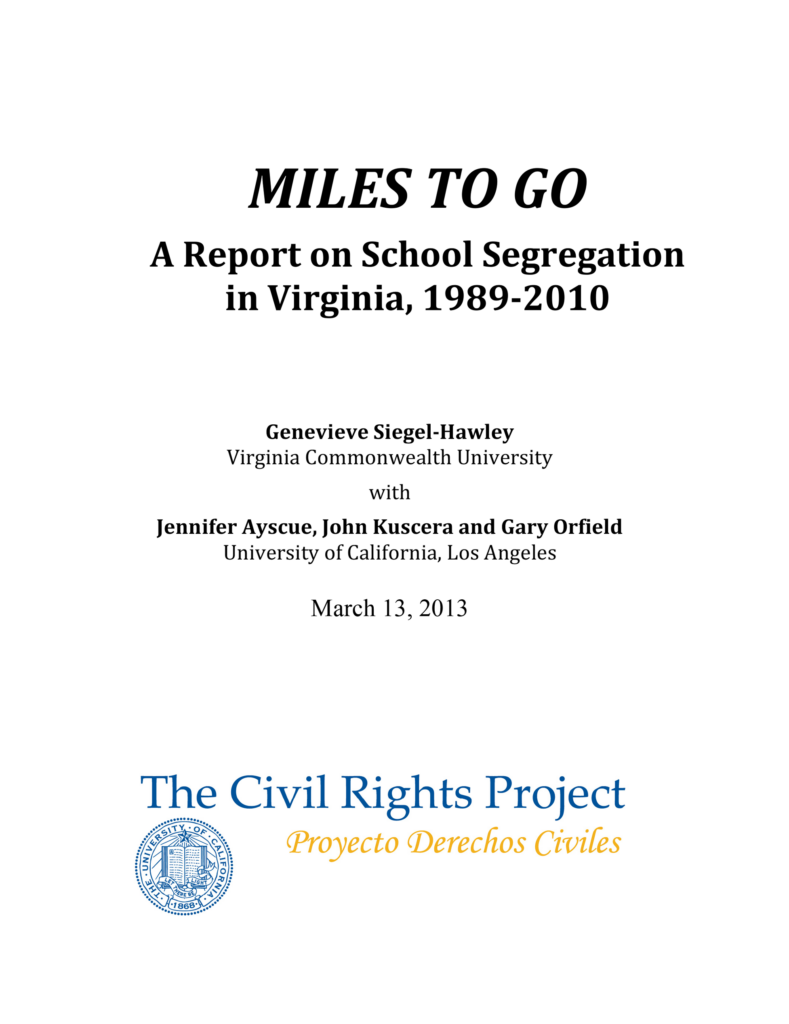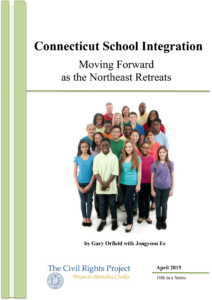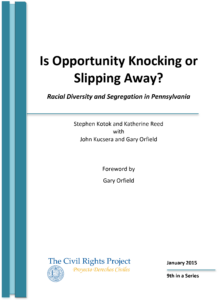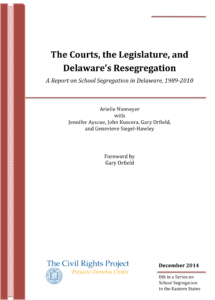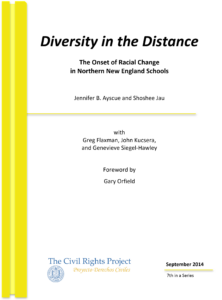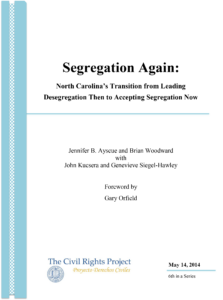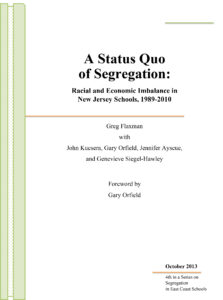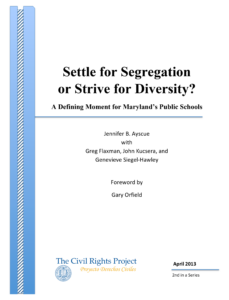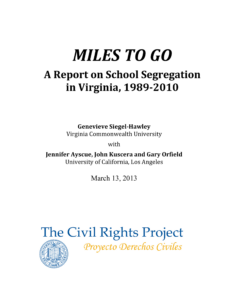Executive Summary
Virginia has a long and complicated history with school desegregation efforts. It is a state that can lay claim both to advancing the goals of Brown v. Board of Education and to impeding them. Over the years, this history has helped shape contemporary patterns of school segregation across Virginia and in her major metropolitan areas. This report examines school segregation trends in the state between 1989 and 2010. Drawing on federal data from the National Center for Education Statistics, it explores patterns at the state, metropolitan and school district level.
More than fifty years after Brown v. Board of Education, significant and rising shares of the Virginia’s black students enroll in segregated schools that are intensely isolated by race and poverty. Broadly, findings also indicate that enrollments in the state, its major metros and districts have become rapidly more diverse, particularly in the past decade. Rising levels of racial diversity bring many opportunities for integration, but a key challenge will be to ensure that metros and districts that become diverse remain diverse—and do not resegregate. Even as levels of segregation between school districts in some of Virginia’s major metros decline, swift racial transition is occurring within districts.
Other major findings in the report include:
Virginia
- The share of white students in Virginia declined sharply between 1989 and 2010, driven by a three-fold increase in the share of Latino students. At roughly a quarter of the enrollment, black students continue to constitute the largest minority group in the state.
- Fully 16% of black students in the state enrolled in intensely segregated minority schools (where white students make up less than 10% of the enrollment) in 2010,rising from about 12% in 1989.
- In 1989, intensely segregated minority schools represented about 3% of all schools in Virginia, more than doubling to almost 6% by 2010.
- Roughly three-quarters of the students attending intensely segregated settings in the state were considered low-income, and low-income students constituted more than 85% of the enrollment in apartheid schools (where white students make up less than 1% of the enrollment).
- The share of Virginia’s Latino students enrolling in intensely segregated schools doubled to 6% between 1999 and 2010.
- More than 60% of Virginia’s Latino students attended a multiracial school (three or more racial groups make up at least 10% of the enrollment) in 2010, up from under 10% in 1989. Asian students experienced a similar increase. Meanwhile, fewer than 30% of black and white students enrolled in multiracial schools in 2010.
- White students remain disproportionately isolated with other whites. In 2010, the typical white student went to a school that was roughly two-thirds white, even though whites accounted for just over half of Virginia’s enrollment.
- The typical Virginia black student went to a school where other black students made up twice the share (nearly 47%) of their overall enrollment in the state (about 24%).
- Students from different racial backgrounds experienced uneven exposure to poverty. The typical black student went to a school in which low-income students accounted for about 50% of the student body. For Latino students, that same figure was about 41%, but for whites it was approximately 32%.
Norfolk-Virginia Beach-Newport News
- The white student population declined from 57% in 1989 to 44% in 2010. In the same year, black students constituted a very sizeable share of the enrollment at 40%. The Latino student population more than tripled, from 2% to 7%, while the share of Asian students remained constant at about 3%.
- The proportion of black students in suburban schools decreased between 1989 and 2010, an unusual development compared to trends nationally and in other major metros in the state.
- The percentage of black students in Norfolk-Virginia Beach-Newport News enrolling in intensely segregated minority settings doubled between1989 and 2010, rising from about 9% to 18%.
- The percentage of Latino students in intensely segregated minority schools also increased (though it remains low), from less than 1% in 2010 to almost 4% in 2010.
- In 1989, roughly 6% of all schools were intensely segregated, compared to nearly 11% in 2010.
- The share of multiracial schools rose from just over 3% to more than 22% in the past twenty years, a more than seven-fold increase.
- Almost 90% of students in apartheid school settings were low income in 2010, along with nearly 80% of students in intensely segregated minority school settings.
- By 2010, the typical black student in the Norfolk-Virginia Beach-Newport News area attended a school where other black students represented a substantial majority of the enrollment, whites made up a rapidly declining proportion of it, and Latino students emerged as a small but significant presence.
- The proportion of predominantly nonwhite school districts in the Norfolk- Virginia Beach-Newport News area more than doubled over the past two decades, while the share of diverse districts shrunk considerably.
- Out of 11 major school districts open in all three time periods, five were predominantly nonwhite by 2010, and three of those transitioned from diverse to predominantly nonwhite in the past two decades.
- The three districts experiencing the most significant changes in the Norfolk region were Hampton, Newport News and Suffolk. All three were characterized as resegregating nonwhite districts.
Richmond-Petersburg
- The share of white students in the Richmond-Petersburg metro declined by almost ten percentage points to 51% between 1989 and 2010, even as the share of the black enrollment remained steady at 37%.
- The percentage of Asian and Latino students enrolled in Richmond-Petersburg metro schools increased considerably over the past twenty years.
- Since 1989, white students made up 10% or less of the enrollment in Richmond-Petersburg’s urban schools.
- The share of whites in metro area suburban schools fell from about 73% in 1989 to 50% in 2010.
- Much of the increase in suburban diversity can be attributed to rising shares of black students attending suburban schools—up to a little over a third of the enrollment by 2010.
- More than one in three black students in the Richmond area went to an intensely segregated minority school in 2010, roughly two times as many as Norfolk- Virginia Beach-Newport News (and five times as many as Northern Virginia).
- Almost one in ten Richmond area black students attended apartheid settings where white students made up less than 1% of the enrollment.
- Nearly 14% of Latino students attended intensely segregated settings in 2010; more than triple the share attending such schools in 1989.
- Approximately 18% of all schools in the metro were intensely segregated in 2010. Just over 4% of Richmond-Petersburg area schools were apartheid settings.
- Fully 85% of students in apartheid schools were low-income in 2010, as were 75% of students in intensely segregated minority schools.
- The typical black student in the Richmond metro attended a school where low-income students accounted for nearly 52% of the enrollment. Meanwhile, white students went to a school where low-income students, on average, made up about 24% of the enrollment—almost a 30 percentage point white-black disparity in exposure to poverty.
- In earlier years, the vast majority of segregation—about 72%—occurred between districts in the Richmond-Petersburg metro (e.g., between Richmond City and Henrico and Chesterfield counties). More recently, however, segregation levels have been roughly the same within and between districts.
- Between 1999 and 2010, the overall share of diverse school districts in the Richmond-Petersburg metro grew substantially, from roughly 46% to 54%.Still, almost 40% of Richmond-Petersburg districts were stably segregated, reporting racially isolated white environments or racially isolated nonwhite environments.
Northern Virginia
- Northern Virginia’s public school enrollment was the most racially diverse of any region in the state.
- Black and Latino students were more likely to enroll in Northern Virginia’s urban schools than in suburban settings (though by increasingly smaller margins), while the reverse was true for Asian and white students.
- Since 1989, increasingly higher shares of black students in Northern Virginia enrolled in predominantly minority and intensely segregated schools, though at much lower percentages than in other metros in the state.
- Northern Virginia is the only region in the state reporting a pattern of more intense concentration of Latino students in segregated minority settings than black students.
- Almost three-quarters of Latinos enrolled in predominantly minority schools in 2010. In the same year, nearly 7% attended an intensely segregated setting.
- Overall shares of students of all races attending multiracial schools were much higher in Northern Virginia than in other regions of the state.
- Nearly 80% of black and Latino students in Northern Virginia attended multiracial schools, compared to about 70% of Asian and American Indian students and just over 50% of white students.
- Northern Virginia was the only major region in the state to report that none of its largest districts were predominantly white.
- The share of predominantly nonwhite school systems quadrupled in the last ten years, from about 11% to 44%.
- Stable and diverse school systems accounted for the largest percentage of major school districts in Northern Virginia between 1999 and 2010.
- On the other hand, though, one in three districts in the region were resegregating nonwhite systems, at a pace of change roughly twice that of the overall metro.
This report provides multiple recommendations for those who are seeking to address resegregation in Virginia’s schools:
- Virginia needs to develop state-level policies that focus on reducing racial isolation and promoting diverse schools. Such policies should address how districts can create student assignment policies that foster diverse schools, discuss how to recruit a diverse teaching staff, provide a framework for developing and supporting intra and inter-district programs, and require that districts report to the state on diversity-related matters for both public and charter schools.
- Districts should develop policies that consider race among other factors in creating diverse schools.
- Magnet schools and transfer programs within and across district borders should also be used to promote more racially integrated schools.
- Fair housing agencies and state and local housing officials need to regularly audit discrimination in housing markets and ensure that potential home buyers are not being steered away from areas with diverse schools.
- Local fair housing organizations should monitor land use and zoning decisions and advocate for low-income housing to be set aside in new communities that are attached to strong schools.
- Housing officials need to strengthen and enforce site selection policies so that they support integrated schools.
- Schools should not be built or opened in racially isolated areas of districts and rezoning policies should not exacerbate racial isolation.
- Local educational organizations and neighborhood associations should vigorously promote diverse communities and schools as highly desirable places to live and learn.
- Efforts should be made to foster the development of suburban coalitions to influence state-level policy-making around issues of school diversity and equity.
- Interested citizens and elected officials should support judicial appointees who understand and seem willing to address the history of segregation and minority inequality and appear ready to listen with open minds to sensitive racial issues brought into their court rooms.
For Virginia to have a healthy multiracial future, it is absolutely urgent that its citizens understand both the values of diversity and the real risks of resegregation. There are a number of possible policy options bearing no relationship to the mandatory plans of the early 1970s. Many instead involve conscious efforts to use school choice and housing opportunity strategies in innovative and appropriate ways. Regardless of the method, the time to proactively harness the opportunities present in the rapidly shifting dynamics of Virginia’s schools is now.
This report is part of a special series, “School Segregation Trends in the Eastern States.” These studies explore trends in enrollment and school segregation patterns from 1989 to 2010 at the state and regional levels, including various metro areas for each state. The reports also document the history of school desegregation in each state and across its geographic regions, including key desegregation cases and remedies, when applicable.
In compliance with the UC Open Access Policy, this report has been made available on eScholarship:
